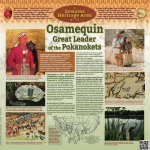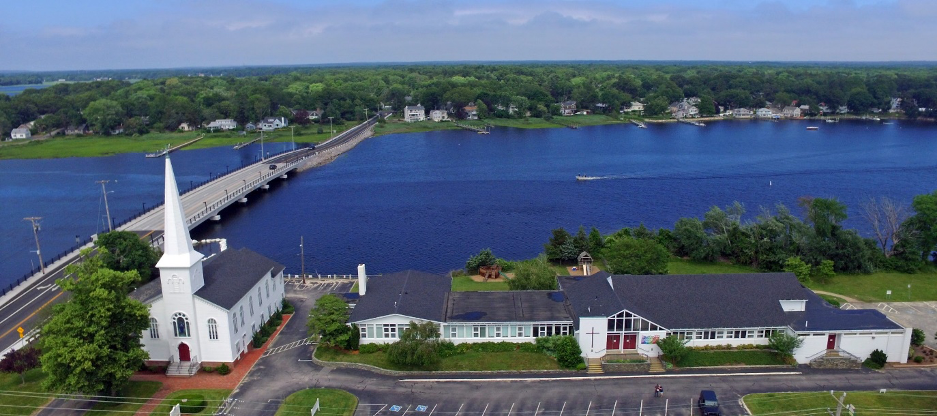An essay by Rev. Racquel Ray submitted for Doctor of Ministry work at Boston University, September 2025
The land upon which the [Barrington Congregational Church] church is built has a long and poetic history. “As the first leaves of sassafras and strawberry emerged in the Wampanoag country during the spring of 1623, a leader stepped forth to confront Plymouth colonist Edward Winslow…all were preoccupied with the illness that had overcome a beloved man, Ousamequin, or Massasoit (his title) – a “great sachem” of the Wampanoags and leader of the adjacent region of Pokanoket.” (Brooks 2018, 1). Barrington Congregational Church, UCC sits on the land of the Pokanoket. The two leaders had developed a strong bond which prompted Winslow to visit Osamequin on his deathbed, “There (Mattapuyst) they told us, That MASSASSOWAT was dead.” ( (Bangs 2004, 70) However, learning that the Indigenous leader was alive, Winslow “set forth with all speed” and came thither to {i.e. to Sowams], (Bangs 2004, 71) having arrived to a house full of elders “making such a hellish noise, as it distempered us that were well” (Bangs 2004, 71).
In an intimate sojourn of compassion Winslow nursed Osamequin to health, “When I came to him…he put forth his hand to me, which I took and he said, “Matta neen wonckanet namen, WINSOW?, that is to say, “O WINSLOW, I shall never see thee again.” (Bangs 2004, 71). Winslow then nursed his friend back to health slowly by feeding the Massasoit with small sips of “a confection [preparation] of many comfortable conserves on the point of my knife.” (Bangs 2004, 71) and progressing to broths made from sassafras and strawberry, and pottages (Bangs 2004, 71) bolstering Massasoit’s health and good will toward the Plymouth colonists. (Rhode Island Historical Preservation Commission and Barrington Preservation Society 1993, 7). Upon recovery, Osamequin broke forth into praises for his renewed bond, “Now I see that the English are my friends, and love me: and whilst I live, I will never forget this kindness they have shewed me” (Bangs 2004, 74). Thus the humane acts of Winslow…in saving, by providential aid, the life of Massasoit…which preserved the infant colony from complete extermination. (Bicknell 1898, 55)
 However, the two men’s sons Pometacomet (Metacom) or Philip and Josiah Winslow forged an unresolved conflict over the terminology and understandings of their fathers’ land inheritances and grants. (Brooks 2018, 40-41) resulting in “King Philip’s War”. (Brooks 2018, 4) The first settlers at Plymouth were granted three large tracts of land for themselves and their associates…one at Patuxet or Plymouth, another at Kennebec, Maine, and the third at Pokanoket or Sowamset. (Bicknell 1898, 58)
However, the two men’s sons Pometacomet (Metacom) or Philip and Josiah Winslow forged an unresolved conflict over the terminology and understandings of their fathers’ land inheritances and grants. (Brooks 2018, 40-41) resulting in “King Philip’s War”. (Brooks 2018, 4) The first settlers at Plymouth were granted three large tracts of land for themselves and their associates…one at Patuxet or Plymouth, another at Kennebec, Maine, and the third at Pokanoket or Sowamset. (Bicknell 1898, 58)
The land underneath the feet of the warring sons is called Sowans and is the native land of the Pokanoket people “whose lands and waterways we benefit from today.” (Barrington Congregational Church, United Church of Christ, n.d.). The church sits on land upon which centuries of blood were spilled. (Hartley 2021) The Winslow narrative “stands at odds with” the Native history (Jennings 2010, 55) as the current Sagamore (chief of chiefs) Dr. William Winds of Thunder Guy retells the story currently. (Hartley 2021) Sagamore is the “place-maker” who speaks as witness describing ancestral events ‘as they are occurring and creating in the process a vivid sense’ that the events of the past could be happening now – on this very land. (Jennings 2010, 55) This very land, granted by formerly prominent Congregationalists of the Plymouth Colony in which the “new church was allowed full liberty of conscience in worship.” (Bicknell 1898, 200)
The members of this infant church were the first to experience the horrors of King Philip’s War (Bicknell 1898, 200) and built a new meeting-house in 1680. (Bicknell 1898, 201) In 1740 the meeting house was moved to its current location on land donated by Joshua Bicknell. (Rhode Island Historical Preservation Commission and Barrington Preservation Society 1993, 13) For over 150 years, from the incorporation of Barrington in 1717 until the late 1850s, the town’s government and old Yankee social structures were closely linked to the Congregational Church. (Rhode Island Historical Preservation Commission and Barrington Preservation Society 1993, 26) In 1856, the town officially separated its government from the Congregational church and added, for the first time, a second denomination. (Rhode Island Historical Preservation Commission and Barrington Preservation Society 1993, 26) Multiple additions and structural updates were added to the church, funded by pew rentals until at least 182l. (Barrington Congregational Church 1987, 9) Singing began in 1817, a melodian added in 1854, and electricity was added in 1893. (Barrington Congregational Church 1987, 25)
Currently, the church stands as the most progressive mainline protestant church in town. The Pokanoket Sagamore is a tenth generation descendant of Osamequin. His daughter, Tracey Dancing Star Brown, Sachem, is eleventh generation descendent from Osamequin as am I from Winslow. The church’s connection with the land and waterways and Indigenous Pokanoket peoples is revisited often through the Land Acknowledgement, the Barrington Interfaith Partnership, standing open invitations, and our resolve to mutual respect and friendships.
References
Bangs, Jeremy D. 2004. Pilgrim Edward Winslow: New England’s First International Diplomat : a Documentary Biography. N.p.: New England Historic Genealogical Society.
Barrington Congregational Church. 1987. The Sounding Board. First ed. Barrington, RI: Barrington Congregational Church.
Barrington Congregational Church, United Church of Christ. n.d. “Justice & Peace.” Barrington Congregational Church, UCC. https://bccucc.org/justice-work/.
Bicknell, Thomas W. 1898. A History of Barrington Rhode Island. 1992 reprint ed. Providence, RI: Snow & Farnum, Printers.
Brooks, Lisa T. 2018. Our Beloved Kin: A New History of King Philip’s War. N.p.: Yale University Press.
Hartley, Ethan. 2021. “Pokanoket Tribe ‘invisible’ no more | EastBayRI.com – News, Opinion, Things to Do in the East Bay.” East Bay Newspapers. https://www.eastbayri.com/warren/stories/pokanoket-tribe-invisible-no-more,92176.
Jennings, Willie J. 2010. The Christian Imagination: Theology and the Origins of Race. N.p.: Yale University Press.
Rhode Island Historical Preservation Commission and Barrington Preservation Society. 1993. Historic and Architectural Resources of Barrington, Rhode Island. Barrington, RI: Rhode Island Historical Preservation Commission.



